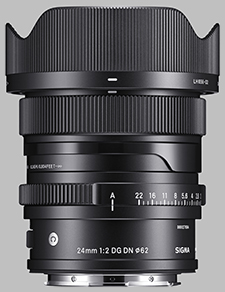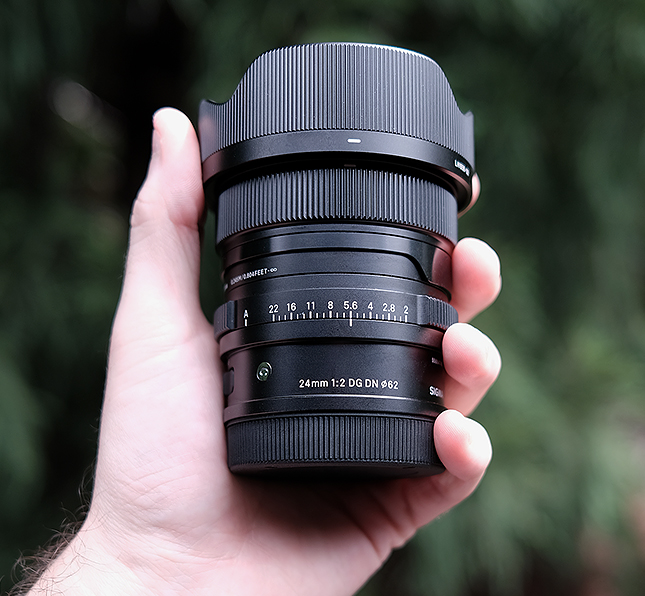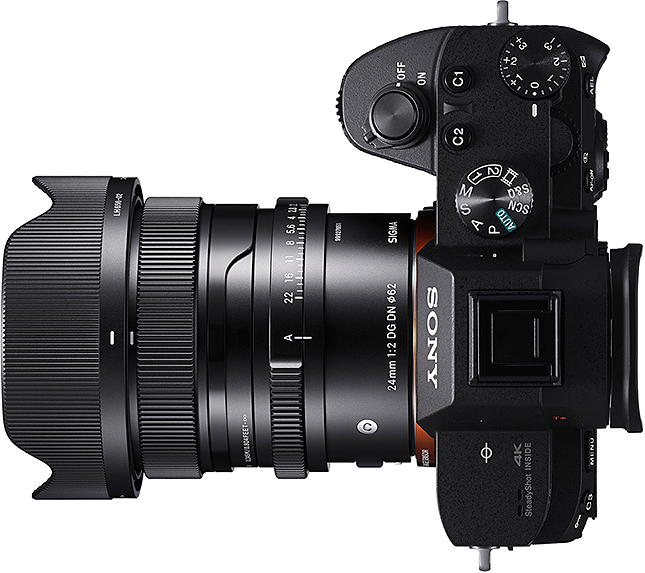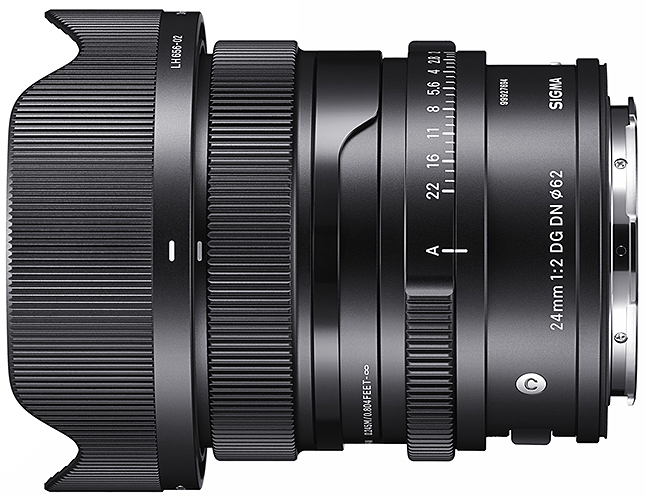| 24mm | |
|---|---|

|
|
Your purchases support this site
Buy the Sigma 24mm f/2 DG DN Contemporary
Updates:
09/09/2021: Hands-on Preview & Gallery Images added
(From Sigma lens literature)
Sigma 24mm f/2 DG DN Contemporary
The all-new 24mm F2 DG DN | Contemporary delivers exceptional edge-to-edge rendering power in an ultra-compact, all-metal body. This impressive, wide-angle, I series prime is now available for L-Mount and Sony E-mount systems.
The 24mm F2 DG DN | Contemporary premium compact prime is the latest prime lens to be added to SIGMA’s growing I series range. It joins four existing I series lenses as well as the new 90mm F2.8, offering superb optical performance, a bright F2 aperture, an all-metal build and a manual aperture ring. Designed from the ground up for mirrorless systems it feels perfectly-balanced on modern full-frame bodies, and boasts exceptional resolving power that can keep up with the latest ultra-high-resolution cameras.
The lens’s advanced optical design produces sharp, high-contrast results from the center of the frame to the far corners, and together with its F2 aperture and wide angle-of-view it’s an excellent choice for night sky photography, events and interiors. Owing to its compact size the lens can be carried around effortlessly, which makes it perfect for day-to-day use. The high quality, all-metal construction, which is found on all of SIGMA’s I series models, makes the experience of owning and operating this lens extremely satisfying.
This new full-frame 24mm F2 prime is designed for photographers who need a sharp, fast, robust, wide-angle optic that will not weigh them down. It is available for L-Mount and Sony E-mount systems.
 |
[Key features]
- I series|Premium Compact Primes for mirrorless users
The SIGMA I series features full-frame-compatible lenses that offer mirrorless users a new and better alternative, both in the experience of shooting with the lens and in the impressive results it is able to achieve.
One of the key advantages of mirrorless cameras is their smaller form-factor, and this new 24mm optic is designed to be perfectly matched to these more compact systems without sacrificing performance. This combination of superb optical quality with exceptional portability, not previously possible with DSLR systems, will bring new opportunities to this and future generations of photographers.
Simultaneously, SIGMA is aware that, in this day and age when we have such huge diversity when it comes to what we use to photograph, as represented by smartphones, people look for something more than a mere act of "taking pictures" when they choose to own a camera and lenses.
SIGMA's excellence in development and processing technologies has been built up since it was founded in 1961, and has become further sophisticated with the introduction of the SIGMA Global Vision in 2012. With this as a base SIGMA has given careful thought to how photographers use and enjoy their lenses, including optical design, advanced functionality, build quality and the experience of picking up and using the lens, and with all of this carefully considered the I series was born.
 |
- New standards of optical performance for the Contemporary line
The SIGMA 24mm F2 DG DN | Contemporary, like the SIGMA 35mm F2 DG DN | Contemporary and the SIGMA 65mm F2 DG DN | Contemporary, combines the highest level of optical performance even at its maximum aperture of F2 and a well-balanced body.
The lens uses two SLD glass elements and one FLD glass element to correct axial chromatic aberration, which is a particular concern with bright lenses. It also incorporates two high-precision glass-molded aspherical elements, made possible by the processing technology of SIGMA's sole production facility in Aizu. This has enabled the total number of lens elements to be kept down and the size and weight of the lens to be reduced, while providing excellent correction of various aberrations.
In anticipation of wide-angle lens applications, SIGMA’s optical designers have ensured the lens resolution is extremely high, and is uniform from the center to the periphery of the image. Sagittal coma flare is also well suppressed, giving the lens a high degree of rendering power that makes it ideal for night sky photography.
The AF drive system incorporates a quiet, high-speed stepping motor. This allows photographers to capture every detail of the spacious 24mm scene with light AF.
 |
- Exceptional I series build quality with a compact form-factor
All I series lenses have an all-metal construction. The precision-cut aluminum parts not only give the barrel a sleek, stylish finish, but provide superb durability that improves the quality of the entire product. Metal materials are also used in internal structures that slide with the operation ring for added robustness. These high-precision components crafted with SIGMA’s cutting-edge metalworking technology are also used in SIGMA’s cine lens line-up for professional cinematographers and provide a tactile, ergonomic feel that make the lens a pleasure to use.
The cover ring between the focus ring and the aperture ring has hairline processing that is also used for the rear cylinder of the Art line. This covering functions as a finger hold when attaching or detaching the lens.
[Additional features]
- Lens construction: 13 elements in 11 groups, with 1 FLD, 2 SLD and 2 aspherical lens elements
- Inner focus system
- Compatible with high-speed autofocus
- Stepping motor
- Compatible with lens aberration correction * Function available on supported cameras only. Available corrections may vary depending on the camera model.
- Support DMF and AF+MF
- Super Multi-Layer Coating
- Aperture ring
- Focus Mode switch
- Petal-type lens hood (LH656-02)
- Magnetic metal lens cap (LCF62-01M)
- Mount with dust and splash resistant structure
- Compatible with SIGMA USB DOCK UD-11 (sold separately / for L-Mount only)
- Designed to minimize flare and ghosting
- Every single lens undergoes SIGMA’s proprietary MTF measuring system
- 9-blade rounded diaphragm
- High-precision, durable brass bayonet mount
- “Made in Japan” craftsmanship
To learn more about SIGMA’s craftsmanship, please visit SIGMA website at:
https://www.sigma-global.com/en/about/craftsmanship/
Notes:
The L-Mount Trademark is a registered Trademark of Leica Camera AG.
Appearance and specifications are subject to change without notice.
Sigma 24mm f/2 DG DN Contemporary
Your purchases support this site
Buy the Sigma 24mm f/2 DG DN Contemporary
Sigma 24mm f/2 DG DN Contemporary User Reviews
The Sigma 24mm f/2 DG DN Contemporary doesn't have any user reviews yet!